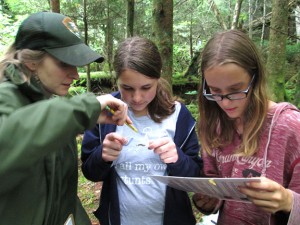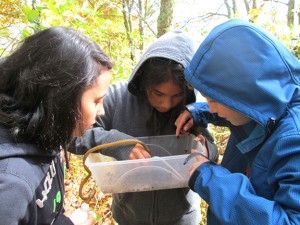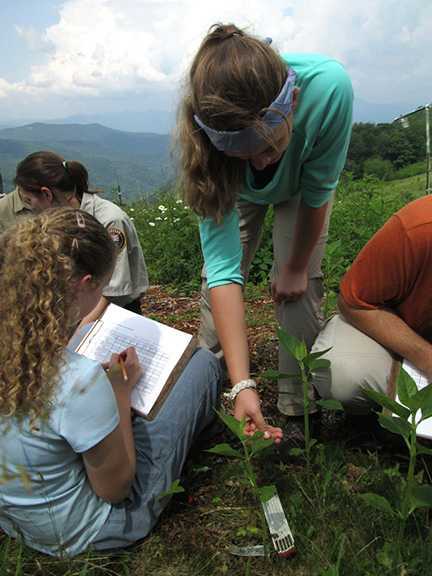by Julie Dodd
For the students, they are trying out the scientific method in the field – analyzing plants for the impact of ground-level ozone.
For teachers, they have the opportunity for their students to engage in hands-on learning in a real world setting.
For scientists, they have a cadre of students to help collect data for long-term environmental studies.
This is one of the Citizen Science Projects conducted at Purchase Knob, North Carolina, that is part of the Parks as Classrooms program, funded in part by Friends of the Smokies.
I talked with Susan Sachs, Ranger and Education Coordinator at the Appalachian Highlands Science Learning Center, about the Parks as Classrooms projects at Purchase Knob.
She explained that the ozone garden biomonitoring project is one of eight different curriculum-based citizen science projects designed to coordinate with the middle school and high school curriculum for students in schools in North Carolina and Tennessee.
To develop these special programs, park science and education staff teamed up with classroom teachers and scientists to plan the units matching grade level curriculum requirements with critical issues in the park, such as the effects of air pollution.
“We have created a really unique place-based experience for the students,” Sachs said.
Student ozone research — practicing the scientific method
The ozone project fits with the seventh grade curriculum in North Carolina that requires students to study the atmosphere and air quality.
The research project actually started in the late 1980s when a researcher began studying ozone’s effect on plants. The work that current seventh graders do in examining Crownbeard plants continues a 14-year study of the ozone’s effect on Crownbeard.

In a training lesson at the students’ schools before the field trip to Purchase Knob, teachers use a website created for this project that has computer-generated leaves for the students to examine for damage made by ozone.
When the students arrive at Purchase Knob, they work in the ozone garden, examining the Crownbeard plants and completing data sheets.
“The students receive the same training at the site that we use for new biologists,” Sachs said.
During the field trip day at Purchase Knob, the students work in two groups, with one group examining the Crownbeard plants in the morning and a second group examining the same plants in the afternoon, which provides a checking system for the data collected each day.
“If there’s a difference in the data collected on a plant by the students, I check the plant myself.”
Not only do the scientists have the data for research but so do the students.
Once back at school, the students have access to the data through the website, including not only their own data but all the data other students have collected. The students continue the scientific process in asking questions about the data and doing their own analysis, which has led to Science Fair projects and other class assignments.
Student questions lead to more research
“We do get good questions from the students,” Sachs said. “Some of the questions have become research papers for others.”

Sachs said that a student had asked if the ozone damage to the Crownbeard could change the nutritional value for animals that eat it. When the research team realized they didn’t have an answer for that simple but great question, it led to a new research study led by a Ph.D-seeking graduate student.
“It’s great that a seventh grader can generate a topic for a Ph.D. student to write a dissertation.”
Sachs said that the Purchase Knob Parks as Classrooms projects help students be part of the scientific process.
“The scientists get good questions, and the kids are learning in a more meaningful way,” she said. “The projects provide a more real world setting for the teachers to use, and we’ve made sure it fits into their curriculum needs and aligns to the teaching standards.”
Educational programs supported by FOTS
Friends of the Smokies helps fund the curriculum development and funds the buses for students and teachers to travel to Purchase Knob, if the school can’t afford the buses. FOTS also provides funds for teacher workshops and for hiring high school interns to work at Purchase Knob in the summer.
Education programs supported by FOTS also include reaching inner city and underserved students with STEM (science, technology, engineering and math) instruction and funding a park liaison with Cherokee Middle School.
Parks as Classrooms activities are held at Cades Cove and the Sugarlands Visitor Center in Tennessee and the Oconaluftee Visitor Center In North Carolina, in addition to Purchase Knob.
FOTS has contributed $2.36 million since 2000 for the Parks as Classrooms program. Approximately 18,000 students per year are involved in Parks as Classrooms activities.
You can learn more about how you can support Parks as Classrooms by visiting the Friends of the Smokies Support a Program website.
